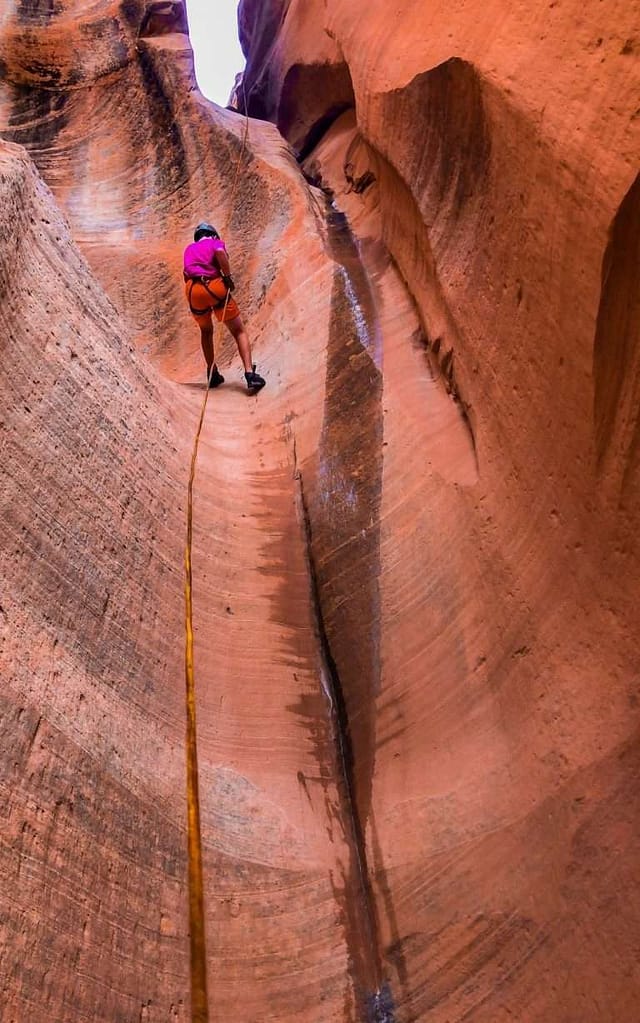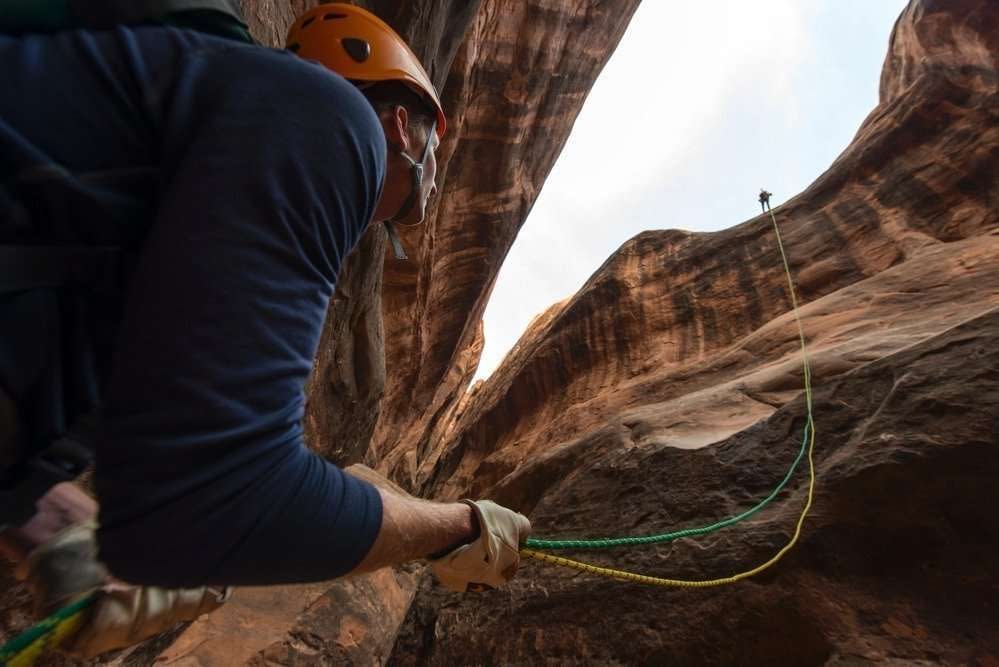Canyoneering Ropes – How to choose the right one
Canyoneering ropes come in many breeds, colors, and styles – all designed for the rugged canyoneering environment.
Some will fit your needs better than others for various reasons. This article will help you pick the right rope to add to your family and will discuss the care and feeding of canyoneering ropes once you adopt one.
Let’s drop right in and see what makes canyoneering ropes so special.
To learn more about canyoneering, check out our canyoneering page.
What makes a canyoneering rope tick?
Canyoneering ropes are not the same as climbing ropes. They’re designed for static loads, and sandy, muddy, wet, and abrasive conditions, and find their greatest joy by getting you from the top to the bottom of a canyon safely. They also know their owners may be carrying them many miles to and from the canyon – often in scorching hot conditions. That’s why canyoneering ropes are often narrower in diameter than climbing ropes.
To survive the harsh conditions of canyon life, canyoneering ropes have evolved a thicker, tougher sheath and tighter weave than their climbing rope cousins. Their sheaths are typically made from polyester or Technora to make them light and durable and often have cores made of polyester, polypropylene, or Dyneema.
The tight weave and core material and design make canyoneering ropes very low-stretch. This is a huge help to their happiness and well-being inside canyons where stretching and bouncing lead to abrasion and damage to the poor ropes. The static nature also helps you, the rappeller, out when you’re 200′ feet over the edge and trying to stay in control of your descent.
All these characteristics make canyoneering ropes uniquely suited for life inside canyons, but how do you choose the right one?
Which canyoneering rope is right for you?
The short answer to this question is – it depends. It’s largely a matter of personal preference. I won’t leave you hanging there though. Let me break down all the characteristics of canyoneering ropes you should consider when you go to the rope shelter to pick the right one to bring home to the kids.

If you already know about canyoneering ropes, but want some solid info on the best ropes on the market, check out the canyoneering rope info sheet we put together for you. It has all the technical specs you need to make an informed decision including, price, weight, diameter, materials, and my comments on the best use for each rope.
Diameter
The current diameter range for mainstream canyoneering ropes runs from 8 mm up to about 10 mm. You can find strange ropes that are only 6 mm but those are for special people with special needs. We won’t discuss those here. Large-diameter ropes over 10 mm can also be found, but again, let’s leave those to the eccentrics.
The main concerns when evaluating a rope by its diameter are durability, weight, and personality.
Personality describes the way the rope behaves while in use. A skinnier rope will typically generate less friction through your rappel device than a thick rope so you’ll have to prepare for that. Skinnier ropes also behave differently when trying to use friction hitches such as prusiks so practicing with your rope before getting into a canyon is recommended.
The weight of a rope can make a big difference when you’re packing 300′ or more feet of it across endless miles of desert terrain. It also helps the rope pack into smaller spaces so you don’t need as big of a pack.
Durability will be increased the thicker the rope is so choosing a skinnier rope is probably best for those with experience in handling canyoneering ropes in canyon conditions since mistakes in setting up rappels over sharp edges or getting ropes sandy and muddy can quickly reduce their life expectancy.
Some other factors to consider when choosing the right diameter canyoneering rope are what rope size your rappel device of choice works best with. Some rappel devices don’t play well with skinny ropes while others aren’t designed for the beefy ones. Read the manufacturer’s instructions.
Also, consider the canyons you plan to descend in the near future with this new rope. If you’re aiming for bolted canyons with clean pulls, any diameter rope will work. If your canyon has difficult raps with sharp overhangs or snaggle-toothed rocks, you’ll want something more durable.
Diameter also depends on your own weight and the weight of those you plan to bring along for the ride. If your rope is skinny and doesn’t like Clydesdales dropping on it, it will give you too little friction.–
Material
It should be obvious that different construction materials give canyoneering ropes different personalities and characteristics. What a canyoneering rope is made of makes a difference. Technora, Dyneema, polyester, and polypropylene are the most common materials used.
- Technora – Technora is an aramid fiber with high tensile strength, high abrasion resistance, and a high melting point. These traits make it ideal for many canyon situations. In canyoneering, long rope pulls can generate substantial heat, so Technora’s heat resistance is a desirable attribute. Technora may sound amazing, but its primary weakness shows up when things get wet – and they often do in canyoneering. Technora can absorb more water than polyester and Dyneema so Technora ropes tend to get heavy and waterlogged when you let them swim.
- Dyneema – Dyneema (AKA – Spectra) melts at a much lower temperature than Technora but doesn’t absorb much water. Dyneema is super strong so a little bit goes a long way and Dyneema ropes tend to be lighter than similarly sized ropes. Dyneema is slick as snot which means it doesn’t hold knots very well so if you’re not confident in your knot skills, Dyneema sheathed ropes may not be the right choice for you. One other interesting tidbit about Dyneema – it doesn’t pick up dyes very well so it’s often plain white, but if the albino rope is the look you’re going for, it’s a great color variety for you.
- Polyester – Polyester makes great canyoneering ropes because the material is cheaper and it’s a very static material compared to the other options. Polyester is hydrophobic meaning polyester canyoneering ropes definitely don’t like drinking in tons of dirty canyon water. They stay pretty dry and also have good abrasion resistance. One area polyester canyoneering ropes tend to get poor marks is their tendency to stiffen up with age. This isn’t necessarily bad, but an old arthritic rope can be a bit harder to handle and can develop a crotchety personality.
- Polypropylene – Polypropylene canyoneering ropes are lightweight and resist absorbing water. They often float depending on the core material and sheath thickness. Polypropylene ropes also melt more easily than others. They can be great ropes for wet conditions, but not always the best all-around.
Other materials are sometimes used to make canyoneering ropes, such as Nylon. Nylon is cheap, but it stretches a ton, absorbs water, and becomes weaker when wet. I don’t recommend Nylon ropes for canyoneering for these reasons.
Weight
The diameter and construction material of your canyoneering rope directly determine its weight. Some ropes are chunky little fellas while others are wiry and scrawny looking. Each one shines in its own element. A rope used for canyons off the side of the road or the canyons where you bring along your pack mule friend can be heavy and will give you extra durability and functionality. Those canyons with long rappels that require a big hike in or out are where the featherweights shine.
Consider the intended use of your canyoneering rope when selecting and think about how heavy a 200′ 11 mm rope will be to haul. They don’t walk on their own you know!
Learn how to not die while canyoneering.
Cost
Between continual permit applications for canyons in Zion National Park and replacing canyoneering ropes each season, the cost of canyoneering adds up. Adopting the purebred, high-performance ropes may seem like a good idea, but recognize that even the most prestigious pedigreed rope will still fall victim to the wiles of the canyon if you spend much time there. Don’t let cost limit your participation in the sport by not being able to afford to regularly replace your ropes.
I recommend starting with a cheaper rope and only buying the pricier ones after you put several canyons behind you. Of course, if you have the cash to spend, some of the pricier ropes sure do have beautiful personalities.
Researching all these details of the commonly used canyoneering ropes can take time so I’ve put together this awesome summary chart of all the common canyoneering ropes.
Other Considerations
Choose lengths that fit the needs of the canyons you plan to drop. Most canyons can be done with either a 120 or a 200′ rope, but you may want a shorter one for canyons with short rappels so you don’t have to pack extra rope
Color may not seem to matter too much, but when you start to grow your rope family to more than a few, it’s good to keep different lengths identifiable based on color.
A few other things to think about when buying a canyoneering rope are the length and color.
Ready to bring home your first canyoneering rope?
If you’re ready to pull the trigger on a canyoneering rope, I put together this great canyoneering rope info sheet to help you learn all about the best ropes on the market.
If you want to take my word for it and skip all the research, here’s what I recommend to get started in canyoneering:
- One 200′ Imlay Canyon Fire
- Two 120′ Imlay Canyon Fire
(Swap this for the Canyonero if you weigh more than 200 lbs.)

Care and feeding of your new rope
okay, so you have a fun new rope to play with. How do you take care of it to ensure it lives a good long life?
How to care for your rope
- Keep it clean – Clean ropes are happy ropes. Your rope is bound to get dirty in the canyon, just be sure to do what you can to avoid throwing it in the mud or sand. When you get home from the canyon, wash your ropes. Avoid using any chemicals to wash your rope with except for mild soap. Never use any oxidizers like bleach.
- Keep it dry – wet ropes degrade more quickly and can grow mold and mildew. Be sure to dry your rope out after it gets wet and before you put it in storage. Hang your rope loosely in a cool place out of the sun to dry it.
- Don’t abuse it – stepping on it, leaving knots in it, storing it in the back of your car in the hot sun, or using your rope in ways you shouldn’t such as sport climbing will kill your rope in a hurry.
- Keep it safe – perhaps the fastest way to destroy your rope is to rappel with it running over sharp edges without any edge protection. Sometimes this can’t be avoided, but do your best to rig your rope in a manner that won’t damage it.
- Get better at rappelling – hero-style rappels with the guy bounding down the side of the building may look cool in the movies, but is poor form for canyoneering. Rappels should be steady, controlled, and not jerky. Shock-loading your rope over a sharp edge or swinging back and forth will wear your rope out faster than nice, easy rappels.
- Keep it out of the chemical cupboard – ropes and chemicals don’t mix. Getting battery acid, oil, bleach, or even a sharpie marker on your rope can weaken it and degrade the fibers. Keep it out of trouble.
- Don’t let it get sunburned – UV rays will degrade your rope over time. It should be stored in a cool dark place – just like your potatoes and onions, just don’t store them together. After cleaning and drying my ropes, I store them loosely coiled in bags to keep them from accidental exposure to anything that would do them harm.
How to know when your canyoneering rope is ready for rope heaven?
Captive-bred canyoneering ropes have a pretty short life span if you take them out in canyons often. Learning to recognize when it’s time to retire your ropes is important for your safety and their happiness. Canyoneering ropes don’t like to be used beyond their safe lifespan.
Depending on the type of malady your rope suffers from, you can cut a long rope into two shorter ropes. Use judgment in when to cut a rope and when to retire the whole thing. When you cut a rope also be sure to document that it was cut and record how long each length is. Not many things are as exciting as thinking you have a 200′ rope only to find out halfway down the wall that you grabbed the 160′ rope.
- Core Shot – core shot is any time the core is visible through the sheath. This is a sure sign you need to cut your rope.
- Core Damage – Each time you inspect your ropes (which should happen every time you pull one out to take on a trip), run the entire length of rope through your hand and feel for bumps, divots, or other imperfections in the core. If you find one, it’s time to cut the rope.
- Sheath damage – if you can see the core at all through a worn-out sheath, either cut the rope if it’s isolated or discard the entire rope if it’s uniform. When you discard a rope, be sure to cut it into short pieces that can’t accidentally be used to rappel or climb on.
- Frayed sheath – this is beyond just a bit of sheath fuzziness. When entire bundles of the sheath are frayed or broken, it’s probably time to cut the rope.
- Shiny rope – if your rope is shiny like it has a glaze on it, you’re probably descending too fast for your belay device. The glazing is typically heat damage to your sheath. Discard!
- Discoloration – if your rope looks like it just got came from the groomers and they bleached or dyed it, it was probably exposed to chemicals or UV rays and should be discarded.
- Old Age – the life expectancy of a rope that never goes out to a canyon to play but sits on the shelf its entire life is still only about 10 years. Soft goods like rope that keep you alive can wear out over time and should be retired even if they still appear to be in good health.
- Loss of Faith – Sometimes there’s no apparent reason why a rope shouldn’t be trusted, but if you feel hesitant about going out on a limb with a specific rope for any reason, retire it.
Summary
Canyoneering ropes are your best friend in the canyon because they’re protecting you from a plummet to your death. Selecting the right canyoneering rope isn’t hard. Just be sure to take good care of your rope once you bring it home.
If you’re interested in learning more about canyoneering and would like to see a post about a specific topic or skill, send me a message or leave a comment and I’ll get right to it.
- Canyoneering Ropes – How to choose the right one
- What makes a canyoneering rope tick?
- Which canyoneering rope is right for you?
- Diameter
- Material
- Weight
- Cost
- Other Considerations
- Ready to bring home your first canyoneering rope?
- Care and feeding of your new rope
- How to know when your canyoneering rope is ready for rope heaven?
- Summary




That’s interesting that your rope could get sunburned. I wouldn’t have thought that the sun would do damage to a rope, but I could see how all the heat and UV light from the sun could be harsh on it. I’ll make sure to keep it out of the sun as much as possible if I get a rope for a canyoneering trip I am thinking about taking my kids on.
The sun is powerful. UV rays can degrade all kinds of things. This is one reason it’s important to always check anchor material such as webbing that you find in canyons. It may look fine, but if you pick it up in your hand, you’ll notice that it’s been cooked by the sun and needs to be replaced. This is also a good reason to not store your gear in your car when you’re not using it. Some people leave ropes in the back of their car where they get direct sunlight. This will definitely shorten the lifespan of your ropes or other gear.